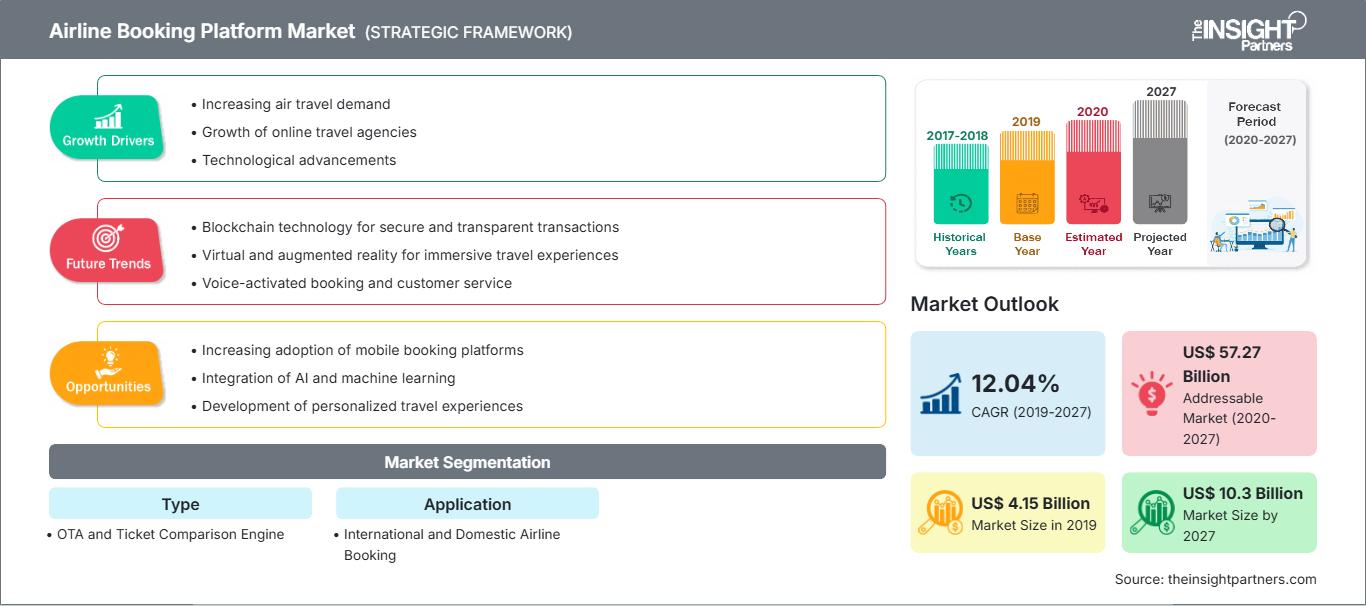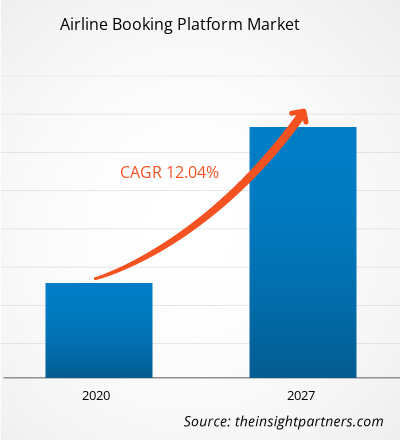Il mercato delle piattaforme di prenotazione aerea è stato valutato a 4.150,65 milioni di dollari nel 2019 e si prevede che raggiungerà i 10.303,88 milioni di dollari entro il 2027. Si prevede che il mercato delle piattaforme di prenotazione aerea crescerà a un CAGR del 12,04% nel periodo di previsione dal 2020 al 2027.
La crescente domanda di viaggi aerei ha portato diversi paesi ad assistere a un aumento del numero di piattaforme di prenotazione aerea negli ultimi anni. La crescente domanda di viaggi aerei ha anche imposto l'adozione di piattaforme tecnologicamente avanzate per prenotare vari servizi di viaggio come la prenotazione di biglietti, il noleggio auto, le prenotazioni alberghiere e molti altri. La rapida crescita del settore dell'aviazione commerciale è principalmente attribuita all'enorme aumento del numero di passeggeri aerei, sia per affari che per piacere. Inoltre, le compagnie aeree stanno monetizzando il miglioramento dei loro servizi aggiuntivi. La crescita del numero di passeggeri aerei è stata registrata negli ultimi anni e ha avuto un impatto significativo sul mercato delle piattaforme di prenotazione aerea. L'aumento del tasso di crescita dei passeggeri aerei è la ragione principale della crescita del mercato delle piattaforme di prenotazione aerea. Le diverse economie dei paesi in via di sviluppo, così come il crescente potere d'acquisto dei cittadini, stanno influenzando positivamente la crescita del mercato. Negli ultimi 15 anni, il numero di passeggeri aerei è aumentato del 5% su base annua a livello globale. Secondo l'International Air Transport Association (IATA), si prevede che il numero di passeggeri aerei raddoppierà tra il 2016 e il 2035.
Il mercato globale delle piattaforme di prenotazione aerea è segmentato in base alla tipologia in OTA e motori di comparazione biglietti. Il mercato delle piattaforme di prenotazione aerea è ulteriormente segmentato in base all'applicazione, in prenotazioni aeree nazionali e internazionali. Il mercato globale delle piattaforme di prenotazione aerea è classificato in base alla geografia in Nord America, Europa, Asia Pacifico (APAC), Medio Oriente e Africa (MEA) e Sud America (SAM).
Personalizza questo rapporto in base alle tue esigenze
Potrai personalizzare gratuitamente qualsiasi rapporto, comprese parti di questo rapporto, o analisi a livello di paese, pacchetto dati Excel, oltre a usufruire di grandi offerte e sconti per start-up e università
Mercato delle piattaforme di prenotazione aerea: Approfondimenti strategici

-
Ottieni le principali tendenze chiave del mercato di questo rapporto.Questo campione GRATUITO includerà l'analisi dei dati, che vanno dalle tendenze di mercato alle stime e alle previsioni.
La trasformazione digitale è da anni una delle principali aree di interesse per molte organizzazioni. Oltre a portare un'efficacia marginale, la tecnologia digitale sta portando cambiamenti radicali in diversi settori. Molti settori, tra cui le compagnie aeree, stanno sfruttando le tecnologie digitali per cogliere nuove opportunità di business. L'International Air Transport Association (IATA) incoraggia gli stakeholder del settore aeronautico a introdurre la trasformazione digitale nelle loro attività, aiutandoli a offrire un'esperienza fluida ai clienti, ottimizzando al contempo sicurezza ed efficienza. Il settore dell'aviazione e dei viaggi è all'avanguardia in termini di digitalizzazione delle operazioni, trasformando così l'esperienza di viaggio per le persone. Le tendenze tecnologiche si stanno unendo per ridefinire i modelli di business nell'ecosistema dell'aviazione e dei viaggi.
Approfondimenti di mercato basati sulla tipologia
Il mercato delle piattaforme di prenotazione aerea è stato segmentato in base alla tipologia in OTA e motori di comparazione viaggi. Diverse agenzie di viaggio e agenti privati stanno adottando strumenti tecnologici di viaggio avanzati e innovativi, come le app mobili, per attrarre e servire clienti a livello globale. La continua adozione di soluzioni di mobilità avanzate e tecnologie di viaggio, con le agenzie che si concentrano sui software di prenotazione online, semplifica la ricerca e l'accesso a tutte le offerte online per i clienti finali e le agenzie secondarie. L'aumento dei viaggi aerei a livello globale è uno dei principali fattori trainanti per l'adozione di piattaforme di prenotazione aerea.
Approfondimenti di mercato basati sulle applicazioni
Il mercato delle piattaforme di prenotazione aerea è stato segmentato in base all'applicazione in prenotazione di biglietti internazionali e prenotazione di biglietti nazionali. Nello scenario attuale, il mercato delle piattaforme di prenotazione aerea nei paesi in via di sviluppo sta prosperando rapidamente, grazie al crescente potere d'acquisto degli individui. Il segmento della prenotazione di biglietti nazionali del mercato delle piattaforme di prenotazione aerea sta acquisendo notevole importanza, poiché i passeggeri sono sempre più propensi a dedicare il loro tempo libero lontano dai loro impegni quotidiani.
Mercato delle piattaforme di prenotazione aereaLe tendenze regionali e i fattori che influenzano il mercato delle piattaforme di prenotazione aerea durante il periodo di previsione sono stati ampiamente spiegati dagli analisti di The Insight Partners. Questa sezione illustra anche i segmenti e la geografia del mercato delle piattaforme di prenotazione aerea in Nord America, Europa, Asia-Pacifico, Medio Oriente e Africa, America Meridionale e Centrale.
Ambito del rapporto di mercato sulle piattaforme di prenotazione aerea
| Attributo del rapporto | Dettagli |
|---|---|
| Dimensioni del mercato in 2019 | US$ 4.15 Billion |
| Dimensioni del mercato per 2027 | US$ 10.3 Billion |
| CAGR globale (2019 - 2027) | 12.04% |
| Dati storici | 2017-2018 |
| Periodo di previsione | 2020-2027 |
| Segmenti coperti |
By Tipo
|
| Regioni e paesi coperti |
Nord America
|
| Leader di mercato e profili aziendali chiave |
|
Densità degli operatori del mercato delle piattaforme di prenotazione aerea: comprendere il suo impatto sulle dinamiche aziendali
Il mercato delle piattaforme di prenotazione aerea è in rapida crescita, trainato dalla crescente domanda degli utenti finali, dovuta a fattori quali l'evoluzione delle preferenze dei consumatori, i progressi tecnologici e una maggiore consapevolezza dei vantaggi del prodotto. Con l'aumento della domanda, le aziende stanno ampliando la propria offerta, innovando per soddisfare le esigenze dei consumatori e sfruttando le tendenze emergenti, alimentando ulteriormente la crescita del mercato.

- Ottieni il Mercato delle piattaforme di prenotazione aerea Panoramica dei principali attori chiave
Gli operatori che operano nel mercato delle piattaforme di prenotazione aerea si concentrano su strategie, come iniziative di mercato, acquisizioni e lanci di prodotti, per mantenere le proprie posizioni nel mercato delle piattaforme di prenotazione aerea. Ecco alcuni sviluppi da parte dei principali operatori del mercato delle piattaforme di prenotazione aerea:
- A novembre 2019, KAYAK Software Corporation ha lanciato un servizio, denominato "KAYAK for Business", per i viaggiatori d'affari, che aiuta a semplificare il processo di prenotazione dei viaggi aziendali.
- A novembre 2019, Trip.com Group Limited ha stretto una partnership con TripAdvisor, Inc., un'agenzia di viaggi americana. La partnership strategica consente all'azienda di affermarsi come leader di mercato nelle funzionalità di prenotazione viaggi.
Mercato delle piattaforme di prenotazione aerea - per tipologia
- OTA
- Motore di comparazione biglietti
Mercato delle piattaforme di prenotazione aerea - per tipologia per applicazione
- Prenotazione aerea internazionale
- Prenotazione aerea nazionale
Piattaforma di prenotazione aerea Market – per area geografica
- Nord America
- Stati Uniti
- Canada
- Messico
- Europa
- Francia
- Germania
- Spagna
- Regno Unito
- Italia
- Russia
- Resto d'Europa
- Asia Pacifico (APAC)
- Cina
- India
- Giappone
- Australia
- Corea del Sud
- Sud-est asiatico
- Resto dell'APAC
- MEA
- Arabia Saudita
- EAU
- Sud Africa
- Egitto
- Israele
- Turchia
- Resto del MEA
- SAM
- Brasile
- Resto di SAM
Mercato della piattaforma di prenotazione aerea: Profili aziendali
- Amadeus It Group Sa
- Blue Sky Booking
- Booking Holdings Inc.
- Easyjet Plc
- Etraveli Group Ab
- Expedia Group
- Igola International Limited
- Kayak Software Corporation
- Kiwi.Com SRO
- Lastminute.Com NV
- Makemytrip Limitato
- Qunar.Com
- Rakuten, Inc.
- Travix International
- Trip.Com Group Limited
- Analisi storica (2 anni), anno base, previsione (7 anni) con CAGR
- Analisi PEST e SWOT
- Valore/volume delle dimensioni del mercato - Globale, Regionale, Nazionale
- Industria e panorama competitivo
- Set di dati Excel
Report recenti
Testimonianze
Motivo dell'acquisto
- Processo decisionale informato
- Comprensione delle dinamiche di mercato
- Analisi competitiva
- Analisi dei clienti
- Previsioni di mercato
- Mitigazione del rischio
- Pianificazione strategica
- Giustificazione degli investimenti
- Identificazione dei mercati emergenti
- Miglioramento delle strategie di marketing
- Aumento dell'efficienza operativa
- Allineamento alle tendenze normative






















 Ottieni un campione gratuito per - Mercato delle piattaforme di prenotazione aerea
Ottieni un campione gratuito per - Mercato delle piattaforme di prenotazione aerea